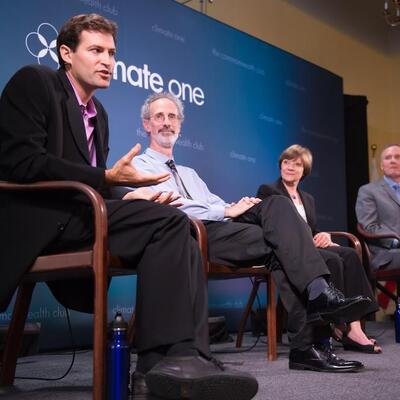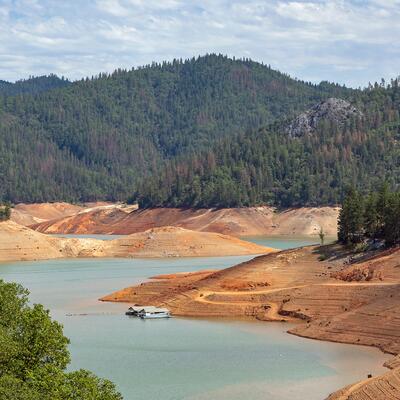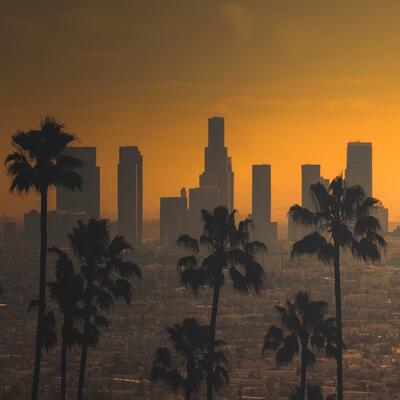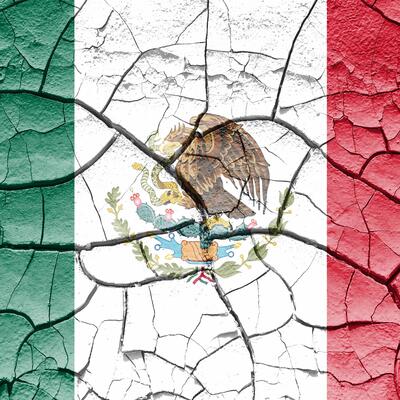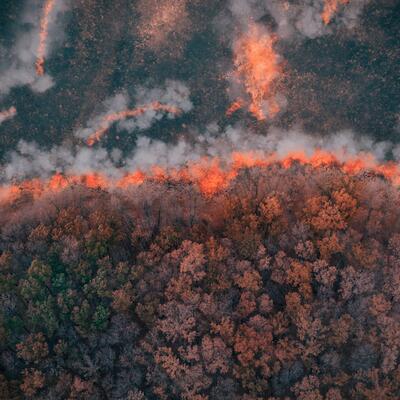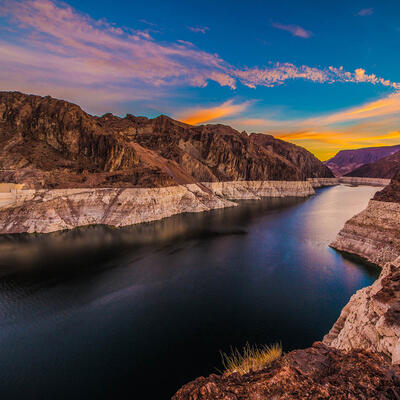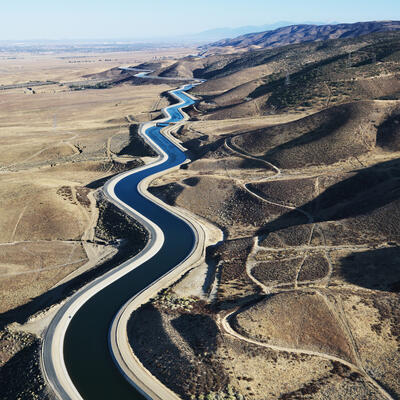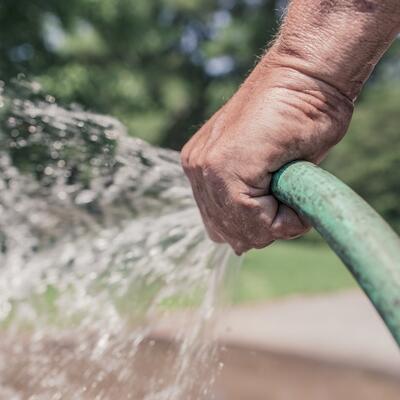
Chasing Water
Guests

Brooke Barton

Peter Gleick

Brian Richter
Summary
Climate change exacerbates effects of both drought and flood conditions worldwide. Too much, then too little – how do we make sense of “water whiplash”?
Brian Richter, Chief Water Scientist, The Nature Conservancy; Author, Chasing Water: A Guide for Moving from Scarcity to Sustainability (Island Press, 2014)
Peter Gleick, President, Co-Founder, The Pacific Institute; Author, Bottled and Sold: The Story Behind Our Obsession with Bottled Water (Island Press, 2011)
Brooke Barton, Director, Water Program at Ceres
Full Transcript
Greg Dalton: Welcome to Climate One, changing the conversation about America’s energy, economy and environment, I’m Greg Dalton. Today we’re discussing the future of water in a hot and crowded world. Scientists tell us that burning fossil fuels will disrupt local climates and deliver “water whiplash”: too much water at times not enough water at others. The wets will get wetter and the dries will get drier. Over next hour we will discuss water around the world and here in California. What can average citizens do to use water more wisely? What can governments do to promote more efficient use of this life-giving resource? Joining our live audience here at the Commonwealth Club in San Francisco we’re pleased to have with us three water experts. Peter Gleick is president and co-founder of the Pacific Institute, a water think tank, and author of The World’s Water, one of the definitive books on water; Brian Richter is chief scientist of the water resource global fresh water program at The Nature Conservancy and author of Chasing Water: A Guide for Moving from Scarcity to Sustainability; and Brooke Barton is director of water program at Ceres, it’s an investor activism group on sustainability. Please welcome them to Climate One.
[Applause]
Greg Dalton: I like to begin by asking you briefly by way of introduction to tell us how you got into water as a profession. Brooke Barton, how did you get into water? I mean we all came from water way back but lets --
Brooke Barton: Well, I guess my first sort of formative experience with thinking about water scarcity was growing up in New Mexico. I grew up in Carlsbad, New Mexico which is a ranching area which is an oil and gas area. Now it’s very much the epicenter of hydraulic fracturing in New Mexico. And really we had a beautiful river, we have a beautiful river running through my hometown.
It was always subject to drought and clearly something that the community appreciated. But we didn’t fully control over the health of that river year to year because a lot of the different activities going on. So that really struck a chord with me growing up. I've come to this profession to a roundabout way. I worked in international development for a while and at Ceres we really had the opportunity to work with corporations and investors in a unique way around water, helping to reframe it as a financial and economic risk that’s important to their bottom lines.
Greg Dalton: Thank you. Peter Gleick, how did you get into water as a profession or as an area of wonder?
Peter Gleick: Thank you and thank you all for coming. I came out of academia. I came out of environmental science, out of engineering, but it became pretty clear to me early that -- that engineering was not the big problem or the big solution, that environmental problems were in the end all connected to water; every one of them that we think about: food, energy, human health, ecosystem health. I worked early on the connection between conflict and resources, and everybody was talking about oil and it just became more and more clear to me that in fact it wasn't oil it was water, and so I’ve continued to work in that field. I grew up on the East Coast but my dad was always drawn to Western rivers and spent an inordinate amount of time for an easterner down in the Colorado River and I think that's emblematic of -- of much of the problems we face worldwide. It's this love of the land and love of water, and yet the realization that it’s tied to everything we care about.
Greg Dalton: Something very special about moving water. Brian Richter, how about you. I think it starts with perhaps paddling. What's your formative experience on water?
Brian Richter: Well yes. I grew up in Southern California, grew up in San Diego and so from a very early age we were very conscious of the scarcity of water, the shortage of water, being told to save water, you know, even back in, well, 1960s and -- but I did have a chance to start working as a whitewater river guide in Sierra Nevada and Stanislaus River. And during the time that I was working as a guide they started, or were about to start construction, I guess it’s New Melones.
And that made me very curious as to why they were gonna build a dam or another dam on the river, and why do we need that dam, and didn’t they know what it was gonna do to the river. And that sort of thing and that line of questioning sent me off to graduate school and I've been pretty much working on that same question, I guess, for the rest of my career trying to figure out how do we manage water in a better way so that we can hopefully have less impact on the natural world.
Greg Dalton: Peter Gleick, let’s talk to click this talk about water internationally. How is water connected with Islamic State and what they’re doing right now?
Peter Gleick: Okay, so that's a great example of conflict over water. We do a lot of work at the institute on all aspects of sustainability but one of the pieces is looking at the historical connections between conflict and water resources and we maintain a chronology, if you like history, we maintain a chronology that goes back three thousand, four thousand years with examples of conflict over water, and unfortunately the earliest examples, three or four thousand years ago, were in ancient Mesopotamia, the Tigris and Euphrates River; today Turkey, Iraq and Syria. And, again unfortunately, the most recent examples are in the same region. It's a region where water crosses borders. It's a region where there are tensions over ideology and religion and politics and access to resources, and unfortunately right now in the Tigris and Euphrates basin we see the conflicts that have arisen for historical reasons, but we see conflicts where water is at the heart of -- of water is a tool of conflict, water is a target of conflict, water is a weapon of war. It's -- it's another example of our inability really to separate politics and water.
Greg Dalton: And isn't there even some example that water played a role in Sudan and other areas in the Middle East now, but it seems to be a lot of civil wars, even civil wars within countries can be water -- water related, Peter Gleick.
Peter Gleick: Yeah, I think the way to think about this is not wars over water but the role that water plays in worsening conflict or triggering conflicts or being used as a weapon or a target of war like we see on the Tigris and Euphrates, but there are other regions, in Africa for example, where pastoralists and farmers are in conflict over control of water, over access to water points. I think as the world grows, as populations grow, as the economy grows, as demand for water grows, the scarcity of water is more and more likely to lead to conflicts of one kind or another. We see conflicts in the Western US and hopefully they won’t be violent conflicts. But they’re political conflicts, and in parts of the world where politics is more difficult sometimes what we have is violence and I think we’re gonna see more of that and not less of that.
Greg Dalton: Brian Richter your book also has a list of some of the high-stress areas include Central Valley of California, the Colorado River, but internationally what are some other flashpoints for water.
Brian Richter: Well just last week I had my first chance to visit Israel and Jordan, so part of the world that Peter’s got to know over -- over the years and it was really an enriching experience for me because when you go there you -- it's -- it's just so obvious to you how central the Jordan River and that water supply is to those countries and so it forms a dividing line between Israel and Jordan. And then of course you have the disputed West Bank, you know, right on that border, that river as well, and those countries literally would not exist without the Jordan River. It’s -- it’s 90, 95% of their water supply and so it's an undercurrent of a lot of tensions as Peter was saying. It’s a source of conflict. There's a lot of fear over the competition, or not having enough.
And yet that river now is down to less than 5% of its original volume. So as it enters the Dead Sea, so it flows out of the Sea of Galilee down river, ends up in the Dead Sea. Basically, no water makes it to the Dead Sea anymore because it’s so heavily used upstream and as a result the Dead Sea, the water level in the Dead Sea is dropping a meter every single year. And so as the shoreline recedes, all the tourist resorts around the Dead Sea are all, you know, left high and dry and kilometers away from the edge of the sea. And so it's -- they have some real serious challenges there. What was fascinating to me Greg is to see that yes, there was tension in the air but also they continue to have a conversation about how they're going to mutually utilize that water resource.
Greg Dalton: Brooke Barton that raises the question of sort of business impact, economic impact of water stress and water lines receding away from the resorts, impact on property values, etc. How are some of the companies involved in Ceres looking at this water stress and conflict, considering it's important to their business?
Brooke Barton: Yeah, I mean we’re entering a whole new paradigm in the business community and how they think about water and they value water. I mean, traditionally in almost every place we can think of the business community has typically been preferenced with cheap, abundant water even in places where water hasn’t been that abundant. So, CFOs of major corporations, you know, when they're looking at their financial statements, water is not coming up as a significant cost driver. It is really the minimalist cost traditionally. And, you know, I think that is changing slowly in some places where we’re seeing the price of water, especially the price of industrial water, go up. But it's not happening fast enough for that to be the motivator. What I think has become more of the motivator and sort of we've been working with the investment community help them asked these questions of companies, but it’s the fact -- you know, these shortages are gonna lead to decision by politicians around who gets the water.
Increasingly, companies are afraid they won't be on the favorable end of that decision. And we know, you know, there have been many examples of companies losing their access to water because of concerns by communities. Coca-Cola, the story of Coca-Cola in India is certainly been repeated often. It is certainly a story that, you know, where concerns about community in Southern India led them to have to shut a bottling plant. The company still feels very strongly that they were not responsible for the pollution and the over extraction issues that were raised in that community, but it nevertheless led to global campaign. It led to significant damage to their brand and the company in turn has very much internalized what this means as a business. The highest, you know, the highest offices in that company are thinking about water as one of their most strategic risks and in the past 10 years have invested 2 billion dollars in water efficiency projects within their own operations globally, but also investing heavily in projects around their plans, really thinking about the watershed, and putting dollars and partnerships in place to help restore rivers, to help replenish groundwater. It’s become a real part of their business model. And, you know, I think that’s something we’re seeing here in California as well. There are companies that, not necessarily because of outside pressure, but because their business livelihood is completely tied up with the future of water in California. Driscoll's Berries which is in -- based out of Watsonville, is one of the largest berry producers in the whole world, is a really interesting example of a company that looked out and saw what a tremendous risk they’re facing in terms of the groundwater that they depend on in the Central Valley, excuse me not in the Central Valley, in the Central Coast aquifer in Pajora Valley. And they have, you know, their CEO Miles Reiter who’s third-generation farmer, grandson of the founder of the company, really took a look and said, you know, if we don't get a hand on the groundwater depletion that is associated with the agricultural production, the berry production in our area, there will be no future here.
And they’ve played an instrumental role in bringing together the growers, the landowners and other parties that traditionally been at each other’s throats in that area and regulators, conservation groups to come up with a plan and working really directly hand and hand with farmers to help them be much more efficient water use, to help recharge aquifers and to really look forward to how they can chart a feature going, you know, in the context of obviously the worst drought this state’s ever seen.
Greg Dalton: Peter Gleick is that kind of collaboration the exception or the rule these days in terms of company saying, oh we got a problem on the horizon it’s not this quarter, it’s not today, we better plan for this and get ahead of it?
Peter Gleick: So the bad news is it’s the exception. But the good news is that it's increasingly the rule. I think Brooke’s point is absolutely right, that companies are an example of groups that are coming to realize the risks associated with our failure to deal with water. There's corporate risk, there's regulatory risk, there’s access risk to the water itself, there's reputational risk to companies and the companies that don't figure that out are the ones that get blindsided. They’re the ones that lose reputation or lose access to water, lose license to operate and the ones that do figure it out, and it's not just companies but it’s the farmers or the cities or the individuals that do figure out that these risks are growing, think about ways of reducing those risks. They figure out ways of restoring groundwater or working with local communities. They figure out ways of using the limited water that they have more efficiently. So, it’s the exception but unless it becomes the rule we’re not gonna move towards sustainable water, and I think the realization that we have to move toward more sustainable management is driving some of these innovations and if that’s the good news I think there's more and more of that to be had.
Greg Dalton: Peter Gleick, you’ve been a big advocate of the human right to water. Is that in conflict with say, creating water markets, in a collision course with some of these corporations or are they compatible?
Peter Gleick: Yes. So, there's an enormous tension in the water world between the human right to water and water as an economic good, and the truth is I think it's both of those things. We’ve done -- we did early work on the human right to water. There was a tremendous debate worldwide about this and in 2010 the U.N. formally declared a legal human right to water and sanitation. It was a great thing and now there's a lot of debate about what that means, how you implement it for companies, for countries, for individuals, but there's clearly a human right to basic needs for water and sanitation, but water is also an economic good. It's fundamental to our corporate operations, to the production of food. We ought to price water. There's a big debate about pricing of water and water markets. Balancing the human right to water and economic aspects of water is another of these challenges in the water world. We want to price water because we want to be used effectively and efficiently, but you don't want to price water in a way that makes it inaccessible to the poorest populations who need water no matter what, no matter their ability to pay. And that’s an interesting challenge.
Greg Dalton: Brooke Barton, is that a challenge? How are some of the companies that you’re involved with at Ceres taken that up? Do they support human right to water or say oh that’s not good for business, we don't want another human rights thing. That could be complicated.
Brooke Barton: Well I’ll grant you that American companies have not usually been at the forefront of the human rights debate but I do --
Peter Gleick: Or the U.S. government.
Brooke Barton: Indeed and -- but I would definitely say that it is becoming much more widespread policy matter within companies that do have a significant impact or interest in water and, you know, numerous companies, some of the ones we’ve mentioned already, Coca‑Cola, Nestlé.
Companies like Ford even, which doesn't have a particularly large water footprint have stepped forward and said, you know we recognize that this -- it’s incumbent on us to understand the impact that our water use has on the communities that are near our facilities, that are affected by our supply chain, and we’re going to start to try to do something about understanding that and hopefully responding to it. And what that means exactly is different for every company. We’re in a very early stage in understand how companies can address human rights, but I think that the point that, you know, when we talk about water markets and there's a lot of enthusiasm right now about how water is the new oil from a kind of financial investment perspective. There's a lot of folks on Wall Street talking about how we’re gonna be in a future of, you know, very sophisticated water markets that, you know, we’re gonna be able to make a whole lot of money on speculation of water and I think we have the message that we're really trying to focus on in the investment community is that water is not like oil, you know, we do need to build water markets that are much more effective in allocating water that do signal the true value of water but we have to keep in mind is this sort of lifeline human right access and we have to keep in mind that water has a value even if it’s in the ground or in the river and that’s different from oil. We don't really put an economic value on oil if it’s never gonna be taken out of the ground, but we really need to think about the fact that water has no real substitutes unlike oil and we all know we’re hopefully moving toward a future where there is less fossil fuel. We do -- we are all investing in generating other energy alternatives. That’s not the case for water, I mean desalination is gonna play its role, hopefully a fairly small one, but we do not have large scale replacement. So, this thinking about that the parallels between the water markets and oil markets there are some flaws and a lot opportunity, I think, to help shape those now while we’re still early in this phase of developing water markets.
Greg Dalton: Brooke Barton is director of the water program at Ceres, an investor’s advocacy group. Other guests today at Climate One are Peter Gleick from the Pacific Institute and Brian Richter from the Nature Conservancy. I’m Greg Dalton. Brian Richter, if there is a market around water as an economic good does the environment lose?
Brian Richter: Well, not necessarily. I think that, you know, these -- both the conflicts between the human access to water as well as how the environment fares in a water market context. We can have all those things together, but they depend very heavily upon -- ultimately upon having good governance, having the institutions and the capacity to manage the water well to meet all of those benefits. So one of the things that gets really mixed up here Greg with water markets and pricing of water is that there's a misunderstanding that you can actually buy the water itself, that you can actually own it as a resource. In most parts of the world that’s actually a fallacy. The government actually retains the ultimate ownership of the water. That's true here in California, it's true in the Western United States, and what they do is they issue the right to use the water. So when we’re talking about a water market what we’re talking about is trading in the rights to use water rather than trading water itself. Now the reason that -- that may seem like a nuance semantics to a lot of you in the audience, but it's important because it highlights the really critical role that government has to play in that in regulating a market, in setting the rules and making sure the environment doesn't get left out, in making sure that human access to water is provided. I think all three of us really understand that with pricing and with markets they can do a lot of good. They can really incentivize. If you have the ability to trade water that you’ve saved, in other words you’re a farmer, you invest in more efficient irrigation practices, you save half of the water. You no longer need to use your full right to use water.
If there's the ability to trade that water, to actually sell the water, lease the water, it's a hell of an incentive for driving conservation and driving better efficiency. So, and to your question more specifically about environment, you know as the Nature Conservancy and, you know, an organization that’s very familiar with real estate transactions. We’ve bought, you know, as much land as just about any private entity within United States over the last 50 years. We see markets as a huge opportunity for us to be able to buy water rights back in systems that have been over appropriated where we have too little water flowing down the rivers. We see the opportunity of markets is, we can use the power of raising money in various ways to buy some of those water rights back and put them back in the river where we need them.
Greg Dalton: Peter Gleick.
Peter Gleick: There's an important point though that I want to emphasize that Brian mentioned and that is that when we gave away all the water --
Brian Richter: Yeah.
Peter Gleick: -- we didn't give it to the environment. We took it from the environment. So all the water rights in California and most of the West are use rights and they’re being used by humans and they come out of environment. We need to figure out a way to -- if we’re gonna move to markets of any kind we have to figure out how ecosystems can participate in markets and we haven’t -- you know, there are examples of that but we haven't done that well enough.
Greg Dalton: Peter Gleick, some people hear markets -- water markets and they hear privatization and that's a scary thing. Is water privatization always scary?
Peter Gleick: Yes.
[Laughter]
Peter Gleick: But it doesn't have to be and this is Brian’s point. Privatization takes a lot of different forms. A bottled water company that pumps public groundwater and turns it into a private little plastic bottle is privatizing water, it’s commodifying a public good. A private company that takes over water management of the water system is a form of privatization that’s totally different. Privatization has risks to it. If water’s a public resource and you have private participation what you really need is strong government oversight. You need regulation, you need monitoring, you need public input into the privatization process, and we published on this at the Pacific Institute. There are reports that you can get. There's a great old report now called the New Economy of Water that looks at this. And we’re not anti-privatization, but there are serious risks to privatization that if you don't have strong governance come back to bite you and so I think that's the balance. 15% of the water systems in the U.S. are private. We mostly have a public water system, 85% public, but 40 million people or so getting water from private water agencies that are overseen by public entities, and it's that governance issue that makes a difference between good and bad privatization.
Greg Dalton: And these days though, there's not a lot of confidence in American Government, at least maybe not Federal Government. Maybe that’s different at the local level where people are regulating water. Have there been agencies that have gone private and then rolled back to the public after the contract period?
Peter Gleick: Yes. A good example is Atlanta. There was a big push toward privatization of these public agencies in the late 90’s and early 2000’s and Atlanta was probably the biggest city that went private. They turned over their public water agency to a private manager and within two or three years they had to reverse that because the prices went way up and the public service went down and complaints went up and pipes weren’t being fixed and they actually rolled that back. Great Britain privatized their water system completely in 1989, I think it was Margaret Thatcher, as part of the privatization push and today all of the British water agencies are private but one of the things they learned right after that was that the government oversight wasn't very good and the Office of Water, which was the agency that oversaw the public interest had to step up their game. They had to come in and they had to basically lay down the law for these private companies that weren’t providing adequate public service. So there's that tension, and it happens but you want strong public oversight.
Greg Dalton: Brian Richter, isn’t it true that a lot -- there's a few but often French‑based global water conglomerates that might be stronger, smarter, bigger than developing countries or even some counties, there's some famous cases in Bolivia and other places where things got quite wild. So, let's talk about the developing world, whether they're kind of have a fair hand when it comes to water multinationals.
Brian Richter: Well thanks Greg, because it's easy for Peter and I and Brooke to talk about pricing water markets aren’t necessarily bad, you just have to have good governance. But you’re raising the point of it's, you know, it is really hard to find good, strong, well-resourced governments in a lot of the developing regions of the world. And so these opportunities for private companies to take over the management of public water supply systems can lead to peril.
And, you know, one of the examples I talk about in the book, this story’s been told many, many times in the water community, is a fairly small community in -- although one of bigger cities in Bolivia called Cochabamba, and it's really been talked about in the news and documentary films and that sort of thing. But in essence, the government and the local communities were really struggling to be able to manage that public water supply system. It wasn't good for the people in that community. There were, you know, no something close to a third or half of the residents that weren’t getting reliable water supply even when the government owned it. So, private company came in there's all sorts of reasons that they will provide as to why they had to raise the rates, but they raised the rates to the point where it put a lot of -- made it unaffordable water price for a lot of the population of that city of Cochabamba. And the citizens rioted and unfortunately a 17-year-old kid got shot in the central plaza during that riot. So, these things can blow up. They can really go south. They can really go bad, but I think then what we would say is be careful, as Peter was saying, you know, privatization is risky and if any entity, the World Bank or any multilateral funder or any supporter is pushing toward privatization they need to be very much aware of those risks and make sure that the government is ready to manage those risks.
Greg Dalton: Brian Richter, you also write about some success stories, China being one of them. Let's talk about the positive side where water is being managed well and models for other governance and water stewardship.
Brian Richter: Well, the one that I really spent a lot of time in my Chasing Water book talking about is Australia and --
Greg Dalton: Set up the big dry and what the lessons are from that.
Brian Richter: Great. So back in about 1997 Australia went into their drought of record. It was called the millennium drought. They also called it the “big dry.” It lasted for about a decade. It lasted until 1997, 1998 in different parts of Australia.
It was absolutely devastating to everything there. The ecological health, there were massive fish kills. There were toxic blue-green algal blooms. Farmers and dairy producers lost entire herds of cattle. Rice went out of production entirely during that time. And I think it was a bellwether for a lot of countries that were on the brink of water scarcity, where they’re so heavily dependent upon using the available water supplies on a normal basis and then all of a sudden you go into a drier than normal period like you're experiencing here in California with your drought and all of a sudden you're getting 20%, 30%, in Australia 60% less rainfall during that 10-year period on average. And so devastating ecologically, devastating economic leave the commonwealth. Another parallel in Australia was the state governments really were sort of dominant with respect to managing water allocation, water quantity in Australia. That's very much the case in the United States. Our Federal Government has a lot of say in water quality; much less say when it comes to water quantity. So the States rule and that was the case in Australia but when things got so bad in Australia, the federal government, the commonwealth government stepped in and said you're not moving quickly enough to adjust to this horrible situation, we’re going to basically take over the water of the Murray-Darling basin and they used a couple of international biodiversity conventions by the way to do that, but they took over. They passed a national act in 2007. It set up a basin-wide authority. So even though the Murray-Darling basin is shared by multiple States in Australia they put one unified authority in charge and charged them with coming up with a new plan for managing the water. To make a long story short, what the plan ultimately said is we have to get our water use down by a third, and we have to do it really, really quickly, because everything is at risk.
Our water security, our economy, the ecological health of the system is at grave risk. We have to get water use down by a third. So as part of that national plan they allocated originally about 10 billion dollars. It’s now grown to about 14 billion dollars of investment in that one river basin to do two things. One was to buy back water rights to get the overall use down to what they thought was a more sustainable level, and second they invested -- they’re investing really heavily in farmers paying them to implement much more efficient irrigation systems. And as they do that the agreement with the government they give them the money but the agreement is that the water that’s saved -- most of the water that’s saved goes back to the commonwealth government and so the combination of actually buying the water rights themselves and then paying for improved irrigation efficiency, those are the two ways that they're getting to a third less water use and Greg, they’re making extremely good progress. They’re getting closer and closer. Probably within the next five years they should be able to get it down to that target level and it will be a much more sustainable level. The use is gonna be brought down a level that they feel is gonna be much easier to handle going forward into the future even during future droughts like the millennium drought that they just had.
Greg Dalton: Brian Richter is the chief scientist of the global freshwater program at the Nature Conservancy. If you're just joining us our guests at Climate One today also include Brooke Barton from Ceres and Peter Gleick from the Pacific Institute. I’m Greg Dalton. Peter Gleick, a delegation of Californians recently went to Australia to learn about the water situation there. Some people think that what happens in Australia might be a harbinger for what happens here. What lessons for California can we learn from Australia?
Peter Gleick: Well we haven't learned the main lesson which is it's smarter to do these things in advance than in a crisis.
They had a millennium drought. Brian’s absolutely right. It started like our drought, went a year and then two years and then three years, and they did what we did, they muddled through. They over pumped their groundwater. They didn't think about water rights, you know, they did minor things. And then it kept going four years and then five and ultimately nine or ten years. By the end of that they were doing things that we frankly should've been doing a long time ago and still are not doing; rethinking water rights, aggressively figuring out how to restore our ecosystems while maintaining some form of a healthy agricultural economy. Their urban water use -- you know we think we’re pretty good in our urban water use. We've done -- most of us have replaced our toilets and our washing machines, and we’re trying to get our water use down. Their urban water use is half or less than half of what a Northern Californian or Southern Californian water uses.
Brian Richter: Does that include all the beer they drink?
[Laughter]
Peter Gleick: Maybe not.
Brian Richter: Okay, but it’s not good beer by the way.
Peter Gleick: So the point is that we’re in a bad drought now. We may be in a long‑term drought as was Australia, and we are not yet doing the things that they learned they had to do and could do successful. I think if next year, you know winter’s just started, the rainy season just started, we don't know whether we’re gonna have a wet year or a dry year. If we have another dry year we’re gonna start to look finally at some of the things that Australia has taken to heart that we’ve not yet taken to heart.
Greg Dalton: Brooke Barton, another thing that happened in Australia's and they built some desalination plants, hugely expensive and then they mothballed them. You said earlier that desal, you hope, will be a small part of it but some people look at desal, San Diego says it’s got to be part of the picture.
Brooke Barton: Yeah, I mean I certainly understand why policymakers are looking at broad set of options for supply security but, you know, what we know is that in most cases desalinated water is part of the total portfolio of water supply options. It’s gonna be the most expensive.
But what often happens is that high-priced desalinated water is sort of averaged across the whole portfolio and prices don't go up for consumers in a way that actually tells them that that additional gallon that they're using that’s now coming from an offshore desal plant is actually much more expensive than all the other water they’re using. So we're not communicating the true cost of these additional supplies to consumers. And often the work that utilities are doing that folk who are responding to drought are doing to communicate and get that sort of efficiency. I mean in Australia they were telling people every day on the nightly news the reservoir levels. They were reminding people persistently to change their habits and people did and more or less that stuck. And so in addition to a lot of rain that came after the end of the big drought there was a change in habits and those desal plants are now mothballed and maybe someday they’ll be used but they’re a tremendous expense. So, I think policymakers have to be very thoughtful about how they invest and the investors in these projects should be very thoughtful about the security of revenue that they’re gonna be getting from cities.
Greg Dalton: Peter Gleick, I heard about a billboard in the Midwest that shows the Great Lakes and there's a straw in each lake and on one straw it says Arizona and the other straw it says California and the other straw says New Mexico, which is basically saying beware that these Southwestern States are after our water. Is that possible? And with the algae bloom would we even want that water?
Peter Gleick: It's possible technically. Engineers love to think about these things. But it's not ever gonna happen. We talk about this all the time. There's a lot of water over here, there's not much water over here, if we can just move it from one place to the other isn't that the solution and --
Brooke Barton: And that’s what you guys have done here.
Peter Gleick: -- and in the 20th century that's what we've done to some degree. We built an enormous infrastructure in California and in the West to move water from one place to another. To store it in the wet season so we can use it in the dry season and that infrastructure has permitted all of us to live the lives that we lead. But it’s really expensive to move water from one place to another. Gravity is not your friend when it comes to moving water and the Rocky Mountains are in the way --
[Laughter]
Peter Gleick: -- between here and there. There's a lot of water and here we want it. So that's not can happen, sort of like desal, it's really expensive. In the end this is partly economics and if desal -- frankly desal’s cheaper than moving water from the Missouri or the Mississippi or the Great Lakes to the West. So we’re not going to do that. We could do it but we’re not gonna do it, and it's not just an economic question frankly, it's now an ecological question. The Great Lakes go up or down a foot, they're not happy and a long-term withdrawal from the Great Lakes wouldn’t make them happy either.
Brian Richter: Greg can I follow up on that just real quickly?
Greg Dalton: Sure, Brian Richter.
Brian Richter: The Great Lakes and exports of water out of the Great Lakes is actually a really interesting story because back in the late 1990’s a private company obtained a water permit from the province of Ontario to pipe water out of Lake Superior, put it in a tanker ship and ship it to Asia. And, I don't remember the volumes, but they were pretty enormous. I mean not, you know, only putting a dent really in Lake Superior, but still large volumes of water. There were such public outcry about that once it got out into the general public that then the eight States and three Canadian provinces that share the Great Lakes banded together and wrote legislation, an international agreement, that prohibits exports out of the Great Lakes. So, technically it could be done, legally it's now illegal to do it but, you know, the forces of economies and when people run out of water it's hard to say, you know, what could happen in the future, I guess.
Greg Dalton: If you're just joining us were talking about water in California and around the world at Climate One today. I’m Greg Dalton. My guests are Brian Richter, the chief scientist for the global freshwater program at the Nature Conservancy; Brooke Barton, director of the water program at Ceres; and Peter Gleick president and cofounder of the Pacific Institute. Brooke Barton, are there some cool technologies and innovation out there that might bring some new things to the water use that might save us a little bit here?
Brooke Barton: Yeah, I mean there are a lot of technologies that are new and cutting edge. There’s a lot of technologies that are not so new and cutting edge that still aren’t being deployed. So, when I think about technology and water it’s -- there, you know, there are still so much low hanging fruit in terms of basic conservation opportunities, so certainly, you know, drip irrigation. There's a lot of kinds drip irrigation but even basic drip irrigation is still not widely deployed in many parts of the agricultural economy both here in California and other places, but on top of that there are all kinds of very interesting technologies and use of big data that’s coming to be built into, you know, irrigation approaches for instance and, you know, variable rate irrigation that allows you to water lesson in corner of the field versus another based on having soil moisture sensors that are sending information across your field into a centralized computer. There's a lot of interesting technology that's being developed that growers are already using that, you know, comes from cloud-based computing, layers of information around weather patterns, evapotranspiration data that can now be used in a much better way to help farmers plan when to irrigate, when to seed, when to harvest. So, just on the agricultural scale there’s a lot, but again I think we're facing some of the same systemic challenges to uptake.
We see the price of water being too low sometimes to justify that irrigation. We see problems between incentives because the folks who are farming the land are not the same as the ones who own the land and therefore have a different stake in improving water efficiency. And more than anything, you know, we simply aren't seeing as much demand from companies, you know, the folks who are buying agricultural produce, for that efficiency. So that’s a big focus of our is how do we get the food and beverage companies that have a stake in these aquifers, have a stake in the rivers that are irrigating the food that enables them to, you know, thrive as companies, to do more to work with farmers, to finance that drip irrigation, to help them take some of the newer technologies much faster.
Greg Dalton: Peter Gleick, there's been a terrible drought in Texas and yet fracking continues in that State. Let's talk about fracking and the drought and water, and whether how’s that gonna affect demand and quality of freshwater.
Peter Gleick: So that's a big topic obviously, but -- and were doing a study actually right now for the State of California on the risks of fracking focusing on pieces of water risks. There are a lot of pieces to that puzzle. One is the amount of water required for fracking -- and fracking is hydraulic fracturing, it’s a method to expand our ability to extract oil and natural gas, and there's concern about potential great expansion fracturing in California, although it would be for oil, not for gas, but the amount of water is an issue. We’re obviously in a drought and we’re a water-short State even when we’re not in a drought. Is that gonna be a challenge? The bigger concern from our perspective is to water quality. We risk contaminating our groundwater aquifers, a lot of produced water comes back up with the oil and gas that's produced and we have to dispose of that and in California as hard as this may be to believe, we still have unlined pits for surface disposal of oil and gas produced water, which is a serious threat to groundwater contamination.
So there are water quality problems, there are water quantity problems. I think it's a problem that we need to understand better before we permit any sort of expansion in this State.
Greg Dalton: And some people would say the industry is moving toward waterless hydraulic fracturing, perhaps using recycled water, salinated water that they’re aware of that water risk. Brooke Barton did you want to comment on fracking and water?
Brooke Barton: Yeah, I just wanted to say that, you know, we’ve looked at this question from the national level. We’ve looked at 40,000 shale wells that have been fracked in the past year and a half and indeed there is, you know, a very shocking correlation between the predominance shale energy development and drought conditions. About 55% of the wells that were drilled where in regions of extreme drought in the past year and a half, so Texas, New Mexico, California, a few other regions. 47% of all the wells that were fracked in the country were in areas of extremely high water stress, meaning water’s already over allocated in those places. And so the oil and gas companies are facing some challenges increasingly to access the water. And something along the lines of 40% were in areas of groundwater depletion and groundwater was being used for this activity. So, it's not just in California. I think the scale of hydraulic fracturing is actually quite small in California at this point. It’s not likely to expand at the scale we’ve seen in other places. And the common refrain in the industry of course from oil and gas producers is, you know, in Texas and many of these states were using less than 1% of total water use. But if you look at it on a regional scale, at a localized scale, there are counties in Colorado, in Texas, New Mexico where something like 85% of all water is going to fracking.
So the communities there are under intense pressure to sell their water, to receive the pollution and really bear the burden.
Greg Dalton: So let's go to audiences’ questions. Welcome to Climate One.
Male Participant: So you guys have been talking about sort of the relatively near-term issues of water challenges we face over the next few years, decades, but there is there is research for example, from the University Corporation for Atmospheric Research that shows a little after the midcentury that most of the contiguous United States will be in drought conditions equivalent to two to three times the 1930’s dust bowl. Can you please comment on what we’re gonna do in those timeframes?
Greg Dalton: Peter Gleick.
Peter Gleick: We’re not prepared for that. So, the reality is the climate’s changing.
The reality is the climate’s changing because of human activities. And the reality is that one of the worst impacts will be on water resources because -- I say this to audiences all the time, but the hydrologic cycle that you all remember from second grade, evaporation, formation of clouds, condensation, precipitation runoff, evaporation. The hydrologic cycle is the climate cycle. And the evidence is already clear that the hydrologic cycle’s being affected by climate change. Temperatures are going up; demand for water goes up when temperatures go up. Precipitation patterns are changing. Storm frequency and intensity is changing. There's been some really interesting new research about the links between the Western drought and some of the atmospheric conditions that have been worsened by human caused climate change. We already don't manage our water resources sustainably. And so we have to think about water sustainable management in general, but we have to think about it in the context of a changing climate not a static climate and so it makes the idea of conservation and efficiency and smart technology and better economics all that much more important in the context of a changing climate.
Greg Dalton: So Peter Gleick, if someone says we have droughts all the time in California, is this drought connected to the climate? What do you say?
Peter Gleick: Yes, okay. So the issue is not whether the current drought in California was caused by climate change. That's a misleading comment, because it's easy to say we don't know. The issue is whether or not the drought, the extreme events, droughts and floods that we are experiencing are now influenced by climate, and the answer to that is unambiguously yes. So would this drought have occurred anyway? Maybe. We get droughts all the time but it's hotter now. The last 36 months in California have been the driest in the historic record. They've also been the hottest in the historic record and that alone is an influence of climate change on drought.
It means demand for water goes up. It means pressure on the existing reservoirs goes up. It means evaporative losses goes up. Hurricane Sandy - caused by climate change? Wrong question. Influenced by climate change. Because sea level has gone up 9 inches in the last century and it occurred at a time when sea level was high, when the tide was high. The flooding caused by Sandy was worsened by climate change. That's the issue. It’s the influence of climate change on these extreme events now.
Greg Dalton: Peter Gleick is president of the Pacific Institute. You're listening to Climate One. Let’s have our next question.
Male Participant: Carter Brooks, artist and philosopher of climate art. So for any of you, but I think Peter probably is the one that can answer this, when one of the places that water is stored is in our alpine regions or mountains here in California obviously, but I sort of, in the long term looking at the Himalayas and the rapid deflation of the glaciers there, wonder about the day when there’s no longer a buffer of water for something like a quarter of the world’s population. So my question is what do we know about how soon that buffer of water will be a concern for us and what are your thoughts on preparing for unreliable water for a large part of the world’s population?
Greg Dalton: The water towers of Asia.
Peter Gleick: Yeah, it's a great question and it's very relevant for California because we depend on snowpack in the winter to store our water. We depend on the slow melt of that snow in the spring and summer because we can't possibly build enough storage, physical storage, to mimic that, to replace that, and were losing that. But this is one of the things that we know with a very high degree of confidence in the climate science community is we’re losing snowpack. Snow lines are going up more of what falls in the winters is falling as rain and not snow and running off faster and will that in them in Himalayas, in the Alps and the Andes, and it’s a water -- it's a terrible complication to our water management problem.
It's not a stop raining. These areas are not to lose water overall, but they’re gonna lose their buffer. They’re gonna change -- we’re gonna have management problems with the change in the timing. We’re gonna see more flooding in the spring than we would've seen otherwise. It's another example of the things that we know are already happening and are gonna get worse.
Brian Richter: Yeah, let me just elaborate --
Greg Dalton: Brian Richter.
Brian Richter: Peter alluded to this problem of there are management challenges with the change in timing. So in much of the West, the timing of the peak of snowmelt runoff off the Rockies and off some of the mountains and the Pacific Northwest has shifted, notably shifted by a week, in some places two weeks, three weeks and others. And that may not seem catastrophic but when you gain an understanding of the fine level of design that we’ve created our water management systems, our reservoirs, our delivery systems to cities and farms, it's actually been -- the designs are fairly sensitive to that amount of shift in water availability. So if you're getting a lot more water coming off sooner in the year, do you have the reservoir capacity to capture that water? Is a lot of it gonna spill? And then after that rush of water is come off earlier and you end up with a lot less water as you get into the dryer summer months in July and August, do you have the capacity to be able to -- is there going to be enough water available to be able to manage, you know, for your needs at that time? So subtle shifts combined with the sensitivity of how we've designed our water management systems that Peter alluded to is gonna be a very, very big challenge in the coming decade.
Peter Gleick: So there's a great way to describe this which is we live in a 21st century with a 21st-century climate with a 20th-century infrastructure and 19th-century laws and policies.
[Laughter]
Greg Dalton: I like that. Brooke Barton.
Brooke Barton: Yeah. I just want to say that, you know, from our vantage point, you know, working with the business and investor community increasingly, you know, corporate leaders, investor leaders are seeing that we can't -- like we’re gonna need to be much smarter in managing these issues on the ground going forwards because we are gonna have climate change.
Climate change is happening but we cannot let it go to four degrees. We cannot let things get to level they’re set to go with the current approach to managing carbon in our economy and in the global economy, and that’s why, you know, companies like General Mills, Mars, Nestlé, Starbucks are coming out and saying, you know, we need climate policy. This is not just about, you know, higher cost for fossil fuels for businesses. This is about losing our access to agriculture, to reliable water. We cannot secure our business into the future and I do think that the voice of business being heard on these issues on both managing water more sustainably and driving much fast reduction in carbon emissions is gonna be critical as we move this conversation forward.
Greg Dalton: Brooke Barton is director of the water program at Ceres, an investor group. Let’s have our next question at Climate One.
Male Participant: John Hurst, I’m a chemist and I enjoy hearing the optimism you have with regards to economics solving this problem or planning solving it. To what degree do any of you go home at night and ask the question, are there enough people on the earth? Is it time maybe to think of this in a grander way that we’re overdoing it in general?
Greg Dalton: Population, often the elephant in the room. Peter Gleick.
Peter Gleick: Yes, absolutely. All of our problems I think would be less severe with a smaller population than a bigger population, especially our water problems because it's water availability and water use. Having said that, we do have a responsibility to meet the basic needs for water and sanitation for everyone, no matter how many people there are. So, we have to get the population problem under control, I agree, but in the meantime we also have to deal with the population that we have and that's -- it’s not either or.
Greg Dalton: And a lot of environmental organizations don't like to touch it. A lot of people, in energy, climate, think that population is a contentious, controversial, social, cultural war issue that they don't want to get involved in.
Peter Gleick: Yeah, I'm not -- I don't subscribe to that. I think we have to talk about it and I'm delighted that there was a question about it. Anne Ehrlich is on our board of directors, she reminds me all the time that we shouldn’t forget about it, so.
Greg Dalton: Let's go to our next question. Thank you.
Male Participant: Hi my name is Stanhope Gould, I’m a retired journalist. Putting together the piece of the gentleman who mentioned that the glaciers are melting, the pressure on groundwater has led Lester Brown to write that the groundwater pressure and the melting of glaciers has created the greatest threat to human food security in the history of the race. Anybody agree or disagree with that?
Greg Dalton: Brian Richter.
Brian Richter: Yes. So, I've been doing a lot of research with some global modeling groups. These are people that are -- they’re computer geeks frankly and they keep track of the water conditions, the water budgets in literally tens of thousands of different watersheds in different aquifers around the world. And so what we know, sort of the best available information on that is that about a third of all the water sources on the planet are being used so heavily that the people that rely upon them are experiencing shortages of water, so about a third of all the water sources. What I mean by shortages. It needs on an ongoing basis and in a lot of places. What I mean by shortage is means on an ongoing basis in a lot of places, it means during certain months of the year in other places, it means only when we have a severe drought in others. But a third of all of them are being -- the people that depend upon those systems are experiencing shortages. About half the world's population is dependent upon those places but the most frightening thing to me is that three quarters of all irrigated agriculture relies upon water sources that are expressing water shortages.
And so yes, we have a very, very serious issue there and there are certain crops that -- tomatoes, corn, wheat, there's a number of crops that the portion that they’re being grown with irrigation are situated in disproportionately areas of water stress. So there's a number of individual crops that are being grown in places where, you know, in 80% of the places where there being irrigated they’re experiencing water shortages, so it's quite frightening, it’s quite frightening.
Male Participant: When you talk to climatologists and people like that, they talk about how fast things are happening. Is time a concern for you people?
Peter Gleick: Oh yeah, absolutely.
Male Participant: How much time? I mean, what are we talking about?
Peter Gleick: I think we’re on a racing train here and nobody’s at the hand, nobody’s at the controls is my feeling. On the groundwater question, another way to think about this is by some estimates a third of global food production comes from unsustainable groundwater basins, basins where we’re over pumping groundwater and the Central Valley comes immediately to mind as does Northern China, as the great parts of India, as extensive parts of Northern Africa. That's unsustainable. We cannot maintain that level of food production because those groundwater resources are going to become more and more expensive. That's peak water. It's like peak oil. It’s a nonrenewable resource when we use it like that. That's a crisis. It’s one of the things that lead to groundwater law for the first time in California this year. We were last State, the dubious distinction of being the last State to have any sort of groundwater law and we do finally, but it's gonna take many, many, many years before, even in California, even in a good year, our groundwater basins are not in gross overdraft.
Greg Dalton: Peter Gleick, let's put this in a form that people can maybe get their hands on. How much water is embedded in a hamburger or a glass of milk? What are some of the water intensive foods that if you care about climate, you care about water, you want to think about when you consume?
Peter Gleick: So there has been in the last few years -- and part of the good news is that we’re talking about water, much more, and part of that is there's a growing understanding that there is water and lots of other resources like energy embedded in the things we buy and consume. It takes water to produce all of the goods and services that we require. It takes a thousand tons of water to make a ton of wheat. That’s how much water takes to grow a ton of wheat. It takes 15 or 16,000 tons of water to grow a ton of cow because we feed grain to cows. That's how we make it. So, our diets are implicated in our water footprint, if you will. A heavy meat diet is more water intensive than a vegetarian diet. And as the world is moving toward a more meat diet, not just the United States which is actually may be leveling off I’m not sure, but much of the rest of the world is consuming more and more meat and that’s a water -- there are water implications to that as well and there's water in everything that we do. There are lots of good websites, The Water Footprint Network, The Global Footprint Network. The Pacific Institute has some data on some of these things about the water in a cup of coffee or a pound of meat or a semiconductor or all of those things if you're interested. Google “water footprint.”
Greg Dalton: I want to thank our guests here today at Climate One; Peter Gleick president and co-founder of The Pacific Institute and author of The World's Water; Brian Richter, chief scientist at global freshwater program at the Nature Conservancy; and Brooke Barton, director of the water program at Ceres. I’m Greg Dalton, free podcast of this other Climate One programs are available on iTunes. Thanks for coming and thanks for listen to Climate One.
[Applause]
[END]
